
KV55 is a tomb in the Valley of the Kings in Egypt. It was discovered by Edward R. Ayrton in 1907 while he was working in the Valley for Theodore M. Davis. It has long been speculated, as well as much disputed, that the body found in this tomb was that of the famous king, Akhenaten, who moved the capital to Akhetaten. The results of genetic and other scientific tests published in February 2010 have confirmed that the person buried there was both the son of Amenhotep III and the father of Tutankhamun. Furthermore, the study established that the age of this person at the time of his death was consistent with that of Akhenaten, thereby making it almost certain that it is Akhenaten's body. However, a growing body of work soon began to appear to dispute the assessment of the age of the mummy and the identification of KV55 as Akhenaten.

Manchester Museum is a museum displaying works of archaeology, anthropology and natural history and is owned by the University of Manchester, in England. Sited on Oxford Road (A34) at the heart of the university's group of neo-Gothic buildings, it provides access to about 4.5 million items from every continent. It is the UK's largest university museum and serves both as a major visitor attraction and as a resource for academic research and teaching. It has around 430,000 visitors each year.

A peg leg is a prosthesis, or artificial limb, fitted to the remaining stump of a human leg, especially a wooden one fitted at the knee. Its use dates to antiquity.

KV20 is a tomb in the Valley of the Kings (Egypt). It was probably the first royal tomb to be constructed in the valley. KV20 was the original burial place of Thutmose I and later was adapted by his daughter Hatshepsut to accommodate her and her father. The tomb was known to Napoleon Bonaparte's expedition in 1799 and had been visited by several explorers between 1799 and 1903. A full clearance of the tomb was undertaken by Howard Carter in 1903–1904. KV20 is distinguishable from other tombs in the valley, both in its general layout and because of the atypical clockwise curvature of its corridors.
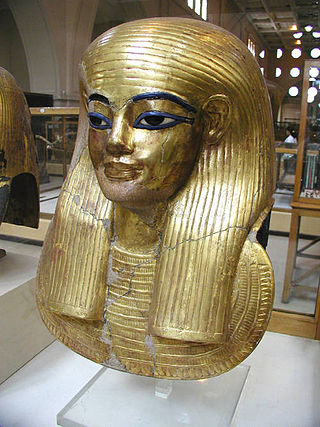
Yuya was a powerful ancient Egyptian courtier during the Eighteenth Dynasty of Egypt. He was married to Thuya, an Egyptian noblewoman associated with the royal family, who held high offices in the governmental and religious hierarchies. Their daughter, Tiye, became the Great Royal Wife of Amenhotep III. Yuya and Thuya are known to have had a son named Anen, who carried the titles "Chancellor of Lower Egypt", "Second Prophet of Amun", "Sm-priest of Heliopolis", and "Divine Father".

El Lahun. It was known as Ptolemais Hormos in Ptolemaic Egypt.

Usermaatre Amenemope was an ancient Egyptian pharaoh of the 21st Dynasty who ruled between 1001–992 BC or 993–984 BC.
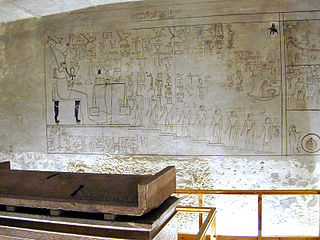
Tomb KV57 is the royal tomb of Horemheb, the last pharaoh of the Eighteenth Dynasty and is located in the Valley of the Kings, Egypt.

Forensic facial reconstruction is the process of recreating the face of an individual from their skeletal remains through an amalgamation of artistry, anthropology, osteology, and anatomy. It is easily the most subjective—as well as one of the most controversial—techniques in the field of forensic anthropology. Despite this controversy, facial reconstruction has proved successful frequently enough that research and methodological developments continue to be advanced.
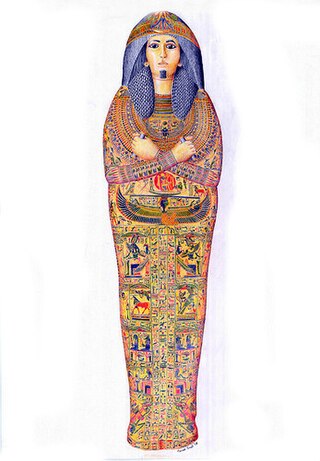
Nesyamun, also known as Natsef-Amun or The Leeds Mummy, was an Ancient Egyptian priest who lived during the Twentieth Dynasty c. 1100 BC. He was a senior member of the temple administration in the Karnak temple complex and held various titles including "god's father of Montu" and "scribe of Montu", and was responsible for presenting the daily food offerings to the gods and tallying the cattle of the Karnak temple estates. Nothing is known about his family.
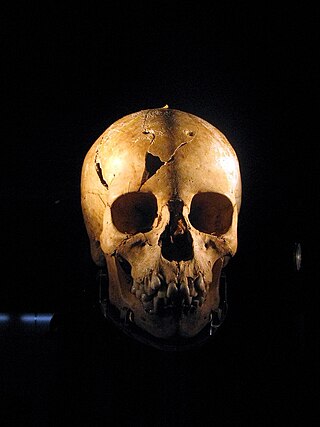
Myrtis is the name given by archaeologists to an 11-year-old girl from ancient Athens, whose remains were discovered in 1994–95 in a mass grave during work to build the metro station at Kerameikos, Greece. The name was chosen from common ancient Greek names. The analysis showed that Myrtis and two other bodies in the mass grave had died of typhoid fever during the Plague of Athens in 430 BC.
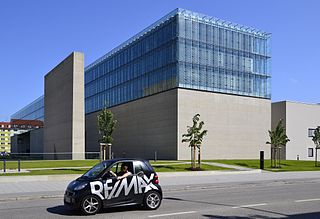
The Staatliches Museum Ägyptischer Kunst is an archaeological museum in Munich. It contains the Bavarian state collection of ancient Egyptian art and displays exhibits from both the predynastic and dynastic periods. The associated small Middle East section displays objects from the areas of Assyrian and Babylonian culture. For decades, the Egyptian museum was located in the Munich Residenz, but it was moved to the Kunstareal in June 2013.

Meresamun was an ancient Egyptian singer-priestess in the inner sanctum at the temple in Karnak. Her mummy, ca. 800 BC, was on exhibit at the Oriental Institute of Chicago Museum of the University of Chicago from February 10 to December 6, 2009. A special exhibition, “The Life of Meresamun: A Temple Singer in Ancient Egypt,” opened in February 2009 and provides a personal look into Meresamun's life.

The Younger Lady is the informal name given to an ancient Egyptian mummy discovered within tomb KV35 in the Valley of the Kings by archaeologist Victor Loret in 1898. The mummy also has been given the designation KV35YL and 61072, and currently resides in the Egyptian Museum in Cairo. Through recent DNA tests, this mummy has been identified as the mother of the pharaoh Tutankhamun and a daughter of pharaoh Amenhotep III and his Great Royal Wife Tiye. Early speculation that this mummy was the remains of Nefertiti was argued to be incorrect, as nowhere is Nefertiti accorded the title "King's daughter."
Tutankhamun's mummy was discovered by English Egyptologist Howard Carter and his team on 28 October 1925 in tomb KV62 in the Valley of the Kings. Tutankhamun was the 13th pharaoh of the 18th Dynasty of the New Kingdom of Egypt, making his mummy over 3,300 years old. Tutankhamun's mummy is the only royal mummy to have been found entirely undisturbed.
Richard Neave is a British expert in forensic facial reconstruction. Neave became an expert in anatomical art and was on the staff of the Unit of Art in Medicine at the University of Manchester. He has used his skill in recreating faces from skulls in police forensic work and in producing images of historical figures. One of his reconstructions was of a bog body known as Yde Girl. In 1998, a murder investigation resulted in a successful prosecution as a result of Neave's work. Neave's archaeological reconstructions include Philip II of Macedon and Midas. In 2001, the television program Son of God used one of three first-century Jewish skulls from a leading department of forensic science in Israel to depict Jesus in a new way. Neave constructed a face using forensic anthropology which suggested that Jesus would have had a broad face and large nose, and differed significantly from the traditional depictions of Jesus in Renaissance art.

Cícero Moraes is a Brazilian 3D designer, whose work in open source programs like InVesalius, Blender and MakeHuman has become a reference in the field of forensic facial reconstruction in his country.
Ann Rosalie David is a British Egyptologist and emeritus professor at the University of Manchester. David served as director of the International Mummy Database.

The tomb of Hetepheres I is an Ancient Egyptian shaft tomb at Giza. It is part of the Eastern Cemetery of the Great Pyramid of Giza and is located near the northeast corner of the northern pyramid of Queen G I-a. The Egyptian queen Hetepheres I was the mother of Khufu and probably the wife of Sneferu.















